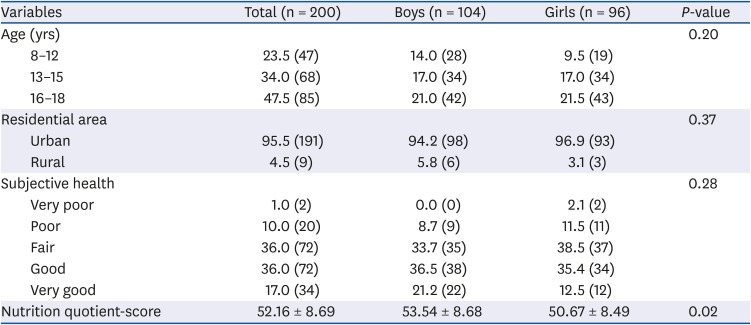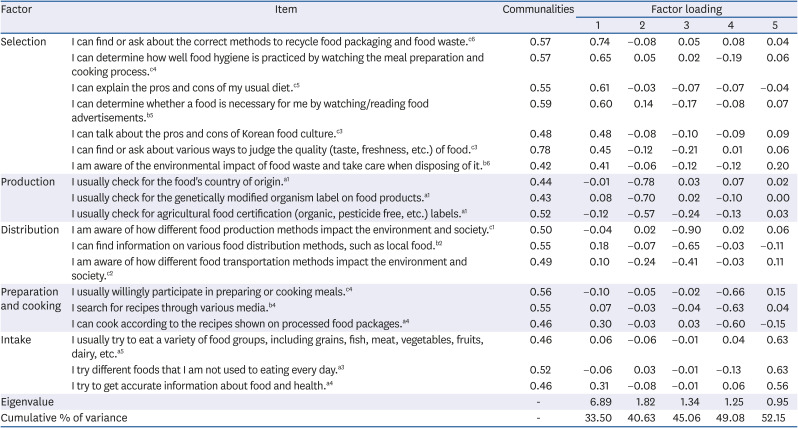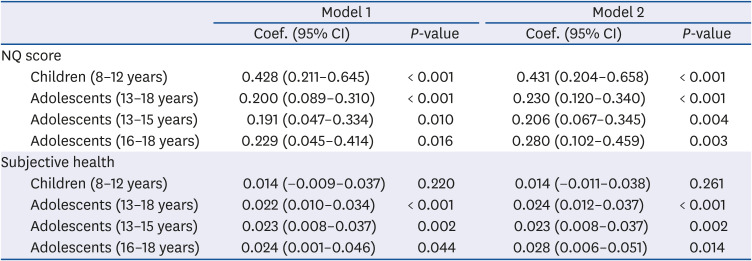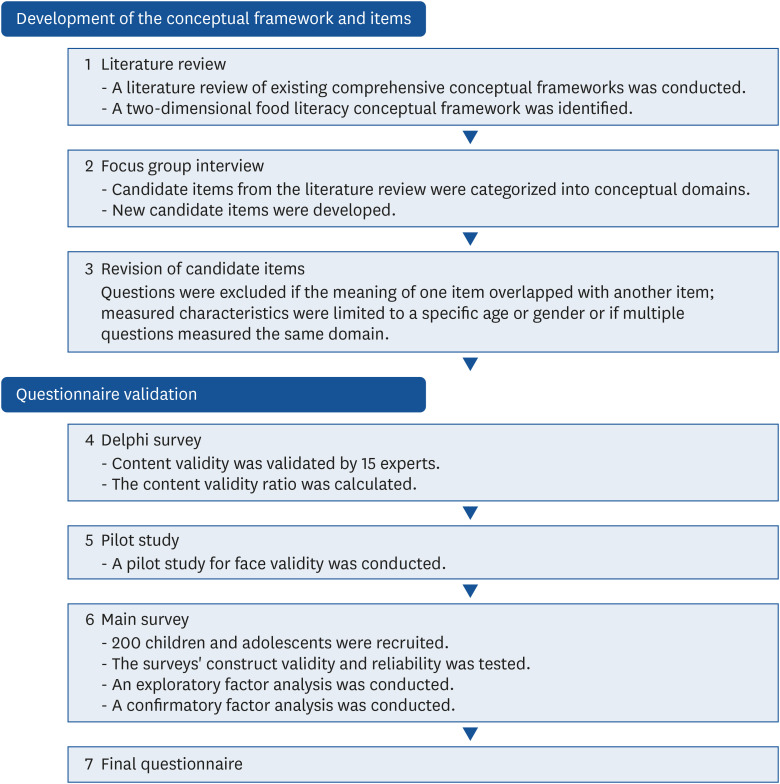1. Das JK, Salam RA, Thornburg KL, Prentice AM, Campisi S, Lassi ZS, Koletzko B, Bhutta ZA. Nutrition in adolescents: physiology, metabolism, and nutritional needs. Ann N Y Acad Sci. 2017; 1393:21–33. PMID:
28436102.
2. Story M. Nutritional requirements during adolescence. McAnarney ER, Kreipe RE, Orr DE, Comerci GD, editors. Textbook of Adolescent Medicine. Philadelphia (PA): W.B. Saunders;1992. p. 75–84.
3. Kremers SP, de Bruijn GJ, Visscher TL, van Mechelen W, de Vries NK, Brug J. Environmental influences on energy balance-related behaviors: a dual-process view. Int J Behav Nutr Phys Act. 2006; 3:9. PMID:
16700907.
4. Ng M, Fleming T, Robinson M, Thomson B, Graetz N, Margono C, Mullany EC, Biryukov S, Abbafati C, Abera SF, et al. Global, regional, and national prevalence of overweight and obesity in children and adults during 1980–2013: a systematic analysis for the Global Burden of Disease Study 2013. Lancet. 2014; 384:766–781. PMID:
24880830.
5. Jung E. Korea Health Statistics 2019: Korea National Health and Nutrition Examination Survey (KNHANES VIII-1). Cheongju: Korea Disease Control and Prevention Agency;2020.
6. Vidgen HA, Gallegos D. Defining food literacy and its components. Appetite. 2014; 76:50–59. PMID:
24462490.
7. Story M, Stang J. Understanding adolescent eating behaviors. Story M, Stang J, editors. Guidelines for Adolescent Nutrition Services. Minneapolis (MN): Center for Leadership, Education and Training in Maternal and Child Nutrition;2005. p. 9–19.
8. Begley A, Paynter E, Butcher LM, Dhaliwal SS. Effectiveness of an adult food literacy program. Nutrients. 2019; 11:1–15.
9. United Nations. THE 17 GOALS | Sustainable Development [Internet]. New York (NY): United Nations;2021. cited 2021 March 16. Available from:
https://sdgs.un.org/goals.
10. Yuen EY, Thomson M, Gardiner H. Measuring nutrition and food literacy in adults: a systematic review and appraisal of existing measurement tools. Health Lit Res Pract. 2018; 2:e134–e160. PMID:
31294289.
11. Widener P, Karides M. Food system literacy: empowering citizens and consumers beyond farm-to-fork pathways. Food Cult Soc. 2014; 17:665–687.
12. Cullen T, Hatch J, Martin W, Higgins JW, Sheppard R. Food literacy: definition and framework for action. Can J Diet Pract Res. 2015; 76:140–145. PMID:
26280794.
14. Hanh N. Sustainable food systems concept and framework. Rome: Food and Agriculture Organization of the United Nations;2018.
15. Ronto R, Ball L, Pendergast D, Harris ND. Food literacy at secondary schools in Australia. J Sch Health. 2016; 86:823–831. PMID:
27714873.
16. Bailey CJ, Drummond MJ, Ward PR. Food literacy programmes in secondary schools: a systematic literature review and narrative synthesis of quantitative and qualitative evidence. Public Health Nutr. 2019; 22:2891–2913. PMID:
31290384.
17. Brooks N, Begley A. Adolescent food literacy programmes: a review of the literature. Nutr Diet. 2014; 71:158–171.
18. Park D, Park YK, Park CY, Choi MK, Shin MJ. Development of a comprehensive food literacy measurement tool integrating the food system and sustainability. Nutrients. 2020; 12:1–13.
19. Azevedo Perry E, Thomas H, Samra HR, Edmonstone S, Davidson L, Faulkner A, Petermann L, Manafò E, Kirkpatrick SI. Identifying attributes of food literacy: a scoping review. Public Health Nutr. 2017; 20:2406–2415. PMID:
28653598.
20. Krause C, Sommerhalder K, Beer-Borst S, Abel T. Just a subtle difference? Findings from a systematic review on definitions of nutrition literacy and food literacy. Health Promot Int. 2018; 33:378–389. PMID:
27803197.
21. Slater J, Falkenberg T, Rutherford J, Colatruglio S. Food literacy competencies: a conceptual framework for youth transitioning to adulthood. Int J Consum Stud. 2018; 42:547–556.
22. Thomas H, Azevedo Perry E, Slack J, Samra HR, Manowiec E, Petermann L, Manafò E, Kirkpatrick SI. Complexities in Conceptualizing and measuring food literacy. J Acad Nutr Diet. 2019; 119:563–573. PMID:
30670348.
23. Lawshe CH. A quantitative approach to content validity. Person Psychol. 1975; 28:563–575.
24. Lynn MR. Determination and quantification of content validity. Nurs Res. 1986; 35:382–385. PMID:
3640358.
25. Kyriazos TA. Applied psychometrics: sample size and sample power considerations in factor analysis (EFA, CFA) and SEM in general. Psychology (Irvine). 2018; 9:2207–2230.
26. Guadagnoli E, Velicer WF. Relation of sample size to the stability of component patterns. Psychol Bull. 1988; 103:265–275. PMID:
3363047.
27. Nunally JC, Bernstein IH. Psychometric Theory. New York (NY): McGraw-Hill;1978.
28. Hu LT, Bentler PM. Cutoff criteria for fit indexes in covariance structure analysis: conventional criteria versus new alternatives. Struct Equ Modeling. 1999; 6:1–55.
29. Tabachnick BG, Fidell LS. Using Multivariate Statistics Title: Using Multivariate Statistics. London: Pearson;2019.
30. Kline RB. Principles and Practice of Structural Equation Modeling. New York (NY): The Guilford Press;2011.
31. Marsh HW, Hau KT, Wen Z. In search of golden rules: Comment on hypothesis-testing approaches to setting cutoff values for fit indexes and dangers in overgeneralizing Hu and Bentler's (1999) findings. Struct Equ Modeling. 2004; 11:320–341.
32. Bentler PM, Bonett DG. Significance tests and goodness of fit in the analysis of covariance structures. Psychol Bull. 1980; 88:588–606.
33. Kim HY, Lee JS, Hwang JY, Kwon S, Chung HR, Kwak TK, Kang MH, Choi YS. Development of NQ-A, nutrition quotient for Korean adolescents, to assess dietary quality and food behavior. J Nutr Health. 2017; 50:142–157.
34. Kim HY, Kwon S, Lee JS, Choi YS, Chung HR, Kwak TK, Park J, Kang MH. Development of a Nutrition Quotient (NQ) equation modeling for children and the evaluation of its construct validity. Korean J Nutr. 2012; 45:390.
35. Food and Agriculture Organization of the United Nations. Sustainable Food Systems. Concept and Framework. Rome: Food and Agriculture Organization of the United Nations;2018. p. 1–8.
36. Cunningham SJ. Predicting obesity in young adulthood from childhood and parental obesity. Emerg Off Pediatr. 1997; 10:204.
37. Evans GW, Otto S, Kaiser FG. Childhood origins of young adult environmental behavior. Psychol Sci. 2018; 29:679–687. PMID:
29447064.
38. Corraliza JA, Collado S. Ecological awareness and children's environmental experience. Pap Psicol. 2019; 40:190–196.
39. Ewert A, Place G, Sibthorp J. Early-life outdoor experiences and an individual's environmental attitudes. Leis Sci. 2005; 27:225–239.
40. Otto S, Evans GW, Moon MJ, Kaiser FG. The development of children's environmental attitude and behavior. Glob Environ Change. 2019; 58:101947.
41. Jørgensen KA. Bringing the jellyfish home: environmental consciousness and ‘sense of wonder’ in young children's encounters with natural landscapes and places. Environ Educ Res. 2016; 22:1139–1157.
42. Tabacchi G, Battaglia G, Messina G, Paoli A, Palma A, Bellafiore M. Validity and internal consistency of the preschool-flat, a new tool for the assessment of food literacy in young children from the training-to-health project. Int J Environ Res Public Health. 2020; 17:1–15.
43. Amin SA, Lehnerd M, Cash SB, Economos CD, Sacheck JM. Development of a tool for food literacy assessment in children (TFLAC). J Nutr Educ Behav. 2019; 51:364–369. PMID:
30851841.
44. Doustmohammadian A, Omidvar N, Keshavarz-Mohammadi N, Abdollahi M, Amini M, Eini-Zinab H. Developing and validating a scale to measure Food and Nutrition Literacy (FNLIT) in elementary school children in Iran. PLoS One. 2017; 12:e0179196. PMID:
28654646.
45. Stjernqvist NW, Elsborg P, Ljungmann CK, Benn J, Bonde AH. Development and validation of a food literacy instrument for school children in a Danish context. Appetite. 2021; 156:104848. PMID:
32828907.
46. Ronto R, Ball L, Pendergast D, Harris N. Adolescents' perspectives on food literacy and its impact on their dietary behaviours. Appetite. 2016; 107:549–557. PMID:
27614212.
47. Vingilis ER, Wade TJ, Seeley JS. Predictors of adolescent self-rated health. Analysis of the National Population Health Survey. Can J Public Health. 2002; 93:193–197. PMID:
12050986.
48. Vaitkeviciute R, Ball LE, Harris N. The relationship between food literacy and dietary intake in adolescents: a systematic review. Public Health Nutr. 2015; 18:649–658. PMID:
24844778.
49. Fosse NE, Haas SA. Validity and stability of self-reported health among adolescents in a longitudinal, nationally representative survey. Pediatrics. 2009; 123:e496–e501. PMID:
19254984.







 PDF
PDF Citation
Citation Print
Print




 XML Download
XML Download